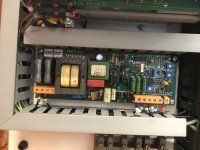andrewmawson
Hot Rolled
- Joined
- Jan 9, 2003
- Location
- UK
I have a CNC lathe with a Mawdsley 27 kW DC motor and I'm having problems running it slow enough for M19 Spindle Orientation to work. It should be run (from parameters I got with the machine) at 5 RPM for M19, but I can't get it going slower than 10 RPM.
Field is supplied by a separate adjustable thyristor supply rated up to 5 amps. Motor plate says excitation should be 170 volts. I measure (at DC) a field resistance of 23 ohms (23 ohms at 170 volts = 7.4 amps). If I tweak the field current up to maximum I can only achieve a field voltage of 165 not the 170 on the plate, and the MENTOR-1 armature controller errors when the motor starts up - ok when tweaked back.
Now I know that DC motor speed can be controlled by field current but am getting confused by what's happening here.
I'd like to be able to confirm that the 23 ohms I'm measuring on the field is reasonable, but the manufacturer went out of business in the mid 90's
Anyone any experience of these things - I'm wallowing at the moment !
Field is supplied by a separate adjustable thyristor supply rated up to 5 amps. Motor plate says excitation should be 170 volts. I measure (at DC) a field resistance of 23 ohms (23 ohms at 170 volts = 7.4 amps). If I tweak the field current up to maximum I can only achieve a field voltage of 165 not the 170 on the plate, and the MENTOR-1 armature controller errors when the motor starts up - ok when tweaked back.
Now I know that DC motor speed can be controlled by field current but am getting confused by what's happening here.
I'd like to be able to confirm that the 23 ohms I'm measuring on the field is reasonable, but the manufacturer went out of business in the mid 90's
Anyone any experience of these things - I'm wallowing at the moment !




